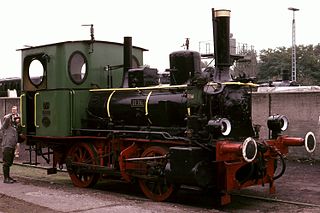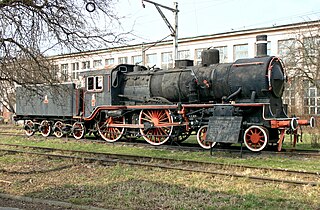| Table of locomotive types |
|---|
| Letters | Locomotive type (German) | Locomotive type (English) | Classes |
| S | Schnellzuglokomotive | Express train locomotive | 01 to 19 |
| P | Personenzuglokomotive | Passenger train locomotive | 20 to 39 |
| G | Güterzuglokomotive | Goods train locomotive | 40 to 59 |
| St | Schnellzugtenderlok | Fast train tank locomotive | 60 to 79 |
| Pt | Personenzugtenderlok | Passenger train tank locomotive |
| Gt | Güterzugtenderlok | Goods train tank locomotive | 80 to 96 |
| Z | Zahnradlokomotive | Cog locomotive | 97 |
| L | Lokalbahnlokomotive | Branch line locomotive | 98 |
| K | Schmalspurlokomotiven | Narrow gauge locomotive | 99 |
The locomotive type (Gattungszeichen) of a German steam locomotive was a secondary classification system introduced after 1924 by the Deutsche Reichsbahn-Gesellschaft (DRG) and comprised four parts:
- A letter from the adjacent table, that specified the type of locomotive (express train engine, passenger train locomotive, etc.).
- A number, usually two-digit, the first digit indicating the number of coupled axles and the second the total number of axles on the locomotive. Tender axles were not included.
- The permitted axle load in tonnes was given next, after a full stop separating it from the preceding axle information.
- If parts of the locomotive exceeded the loading gauge, this was indicated with a triangle over the axle load (see photo below right). If this was simply a removable chimney fitting, this was indicated with an additional bar above the point of the triangle (photo below left).
Example: A DRG Class 01 express train locomotive had the following type classification: S36.20. That meant: Express train locomotive (Schnellzuglokomotive) with 3 coupled axles, a total of 6 axles and an axle load of 20 tonnes
It was intended to use this type classification system for electric locomotives as well. But because electric locomotives could be used for any duty, this plan was given up.
The primary classification system was based on class numbers which, in the case of steam locomotives ran from 01-99 (see table, right hand column).

The Deutsche Reichsbahn-Gesellschaft's BR 01 steam locomotives were the first standardised (Einheitsdampflokomotive) steam express passenger locomotives built by the unified German railway system. They were of 4-6-2 "Pacific" wheel arrangement in the Whyte notation, or 2′C1′ h2 in the UIC classification. The idea of standardisation was that it would reduce maintenance costs; i.e. if a BR 01 whose engine shop was in, say, Berlin broke down in Dresden, instead of having to ship the necessary part from Berlin and take the locomotive out of service, a part from the Dresden shop could be used as all of the engines, parts, and workings were exactly the same and produced nationwide. Thus it was a "standard" product for engine shops.
The different railway companies in Germany have used various schemes to classify their rolling stock.

The Prussian state railways' Class P 10 were 2-8-2 "Mikado" type passenger-hauling steam locomotives built for hauling heavy express trains in the hilly terrain of the Mittelgebirge. They were the last Prussian passenger train steam locomotives to be developed in Prussia before the state railways were merged into the Deutsche Reichsbahn, who eventually designated them as DRG Class 39.

The Bavarian Class D VI were German, 0-4-0, steam locomotives of the Royal Bavarian State Railways. They were light, twin-coupled, saturated steam, tank engines. Maffei supplied the first 30 locomotives from 1880 to 1883, and Krauss delivered a further 23 up to 1894.

The DRB Class 42 was a type of steam locomotive produced for the Deutsche Reichsbahn. It is one of the three main classes of the so-called war locomotives (Kriegslokomotiven), the other two being class 50 and 52.

The German Steam Locomotive Museum or DDM is located at the foot of the famous Schiefe Ebene ramp on the Ludwig South-North Railway in Neuenmarkt, Upper Franconia. This region is in northern Bavaria, Germany. The DDM was founded in 1977.

The German Class 41 steam locomotives were standard goods train engines (Einheitslokomotiven) operated by the Deutsche Reichsbahn (DRB) and built from 1937 to 1941.

The German DRG Class 02 engines were standard (Einheitslokomotiven) express train locomotives with the Deutsche Reichsbahn-Gesellschaft. Number 02 001 was the first Einheitsdampflokomotive in the DRG to be completed.

The Einheitsdampflokomotiven, sometimes shortened to Einheitslokomotiven or Einheitsloks, were the standardized steam locomotives built in Germany after 1925 under the direction of the Deutsche Reichsbahn-Gesellschaft. Their manufacture made extensive use of standard design features and components.

The Württemberg Hz were 0-10-0 rack and adhesion steam locomotives, that were initially developed by the Royal Württemberg State Railways, but were delivered to the Deutsche Reichsbahn-Gesellschaft (DRG) in the mid-1920s.

Between 1934 and 1941 the Deutsche Reichsbahn (DRG) converted a total of 691 former Prussian-built Class 55.25–56 steam locomotives; the result was the DRG Class 56.2–8. The carrying axle enabled higher speeds and the engine could even be used as a passenger train locomotive. In addition the average axle load was lower, so that these locomotives could also be used on branch lines. The conversion entailed moving the boiler forward and raising it somewhat. The vehicles were given operating numbers between 56 201 and 56 891, although the numbering was not continuous.
Three different types of German electric goods train locomotive belonged to the Deutsche Reichsbahn's DRG Class E 91. In addition to the standard locomotives (Einheitslokomotive) described below there was also a Prussian class that was given the designation E 913 in 1927.
The DRG locomotive classification system was developed by the German Imperial Railway Company or Deutsche Reichsbahn-Gesellschaft (DRG), which was formed in 1924 following the merger of the German state railways (Länderbahnen) in 1920. A common classification and numbering scheme was needed in order to organise effectively the four hundred or so different steam locomotive classes taken over from the state railways, as well as new locomotives. This process lasted until 1926. Only then was the final renumbering plan fixed.

The DR locomotive classification scheme in East Germany in the initial post-war period used the DRG system, consisting of a class number (Baureihennummer) followed by a serial number (Ordnungsnummer). With the introduction of computerised (EDP) numbers in 1970 as part of the UIC framework, the system was fundamentally changed for the first time.

The German DRG Class 95 are ten-coupled tank locomotives with a 2-10-2 wheel arrangement, which were procured by the Deutsche Reichsbahn in 1922 for hauling heavy goods trains on steep main lines. Because the development of this class was started by the Prussian state railways, it was designated as the Prussian Class T 20.
The Henschel-Wegmann Train was an advanced passenger express train operated by the Deutsche Reichsbahn in Germany, which ran non-stop express services between Berlin and Dresden from June 1936 to August 1939. Both the DRG Class 61 steam locomotive at its head as well as the coaches were streamlined.

The Prussian S 6 was a class of German steam locomotive with a 4-4-0 wheel arrangement operated by the Prussian state railways for express train services.

A Kleinlokomotive or Kleinlok is a German locomotive of small size and low power for light shunting duties at railway stations and on industrial railways. Most are powered by diesel engines, but Kleinloks with steam, petrol, or electric engines were also produced.
This page is based on this
Wikipedia article Text is available under the
CC BY-SA 4.0 license; additional terms may apply.
Images, videos and audio are available under their respective licenses.














